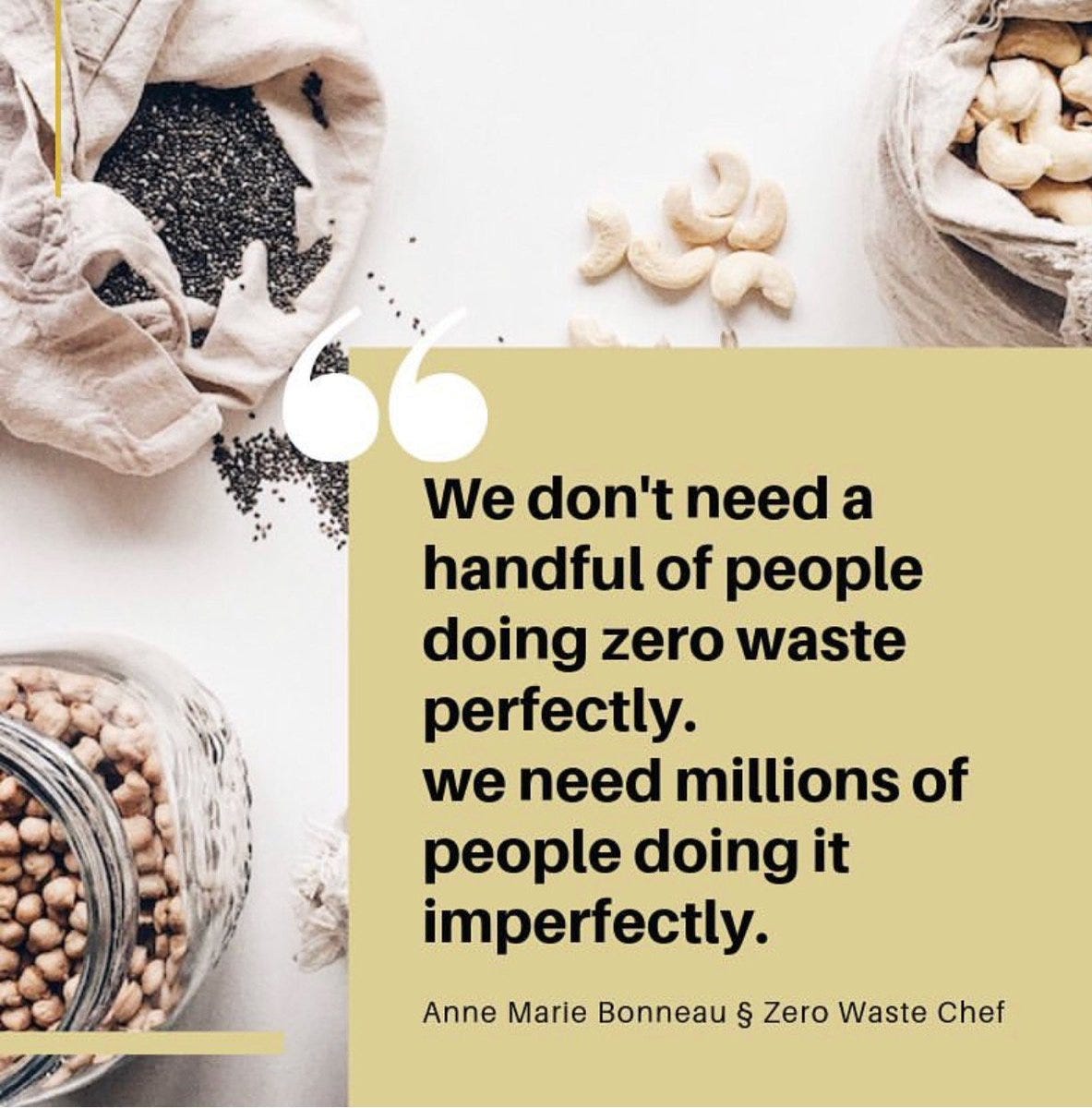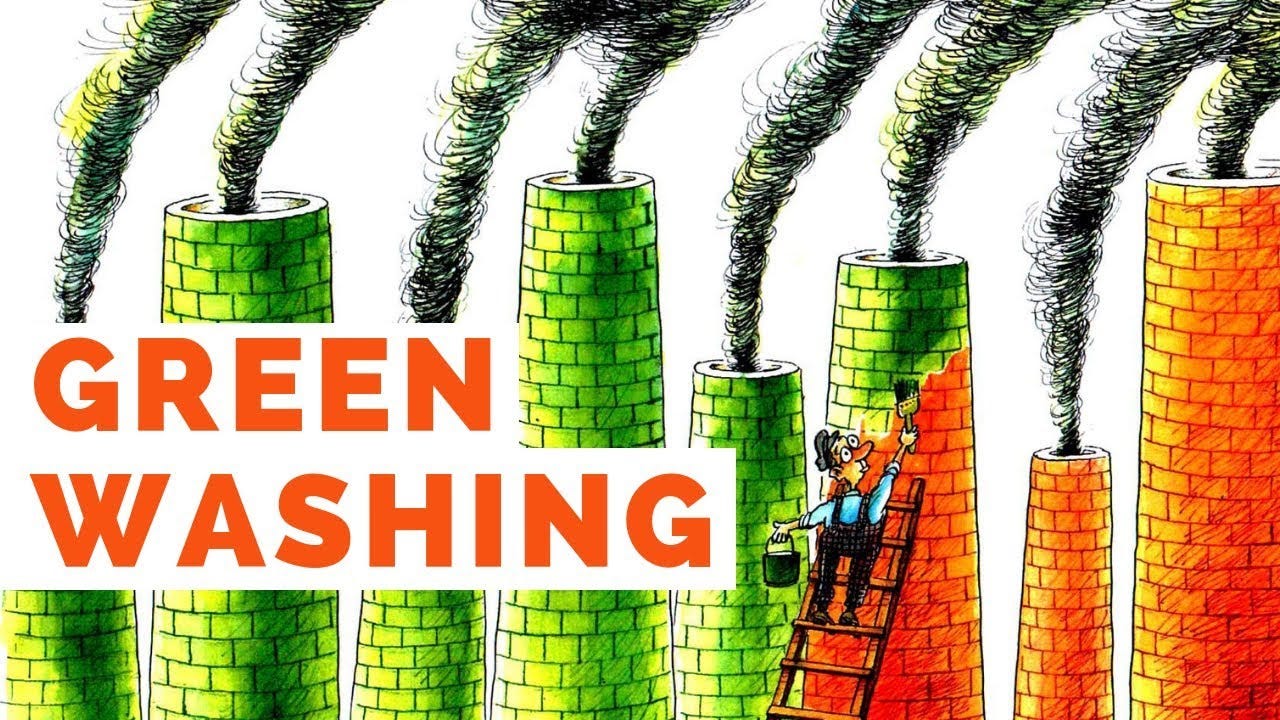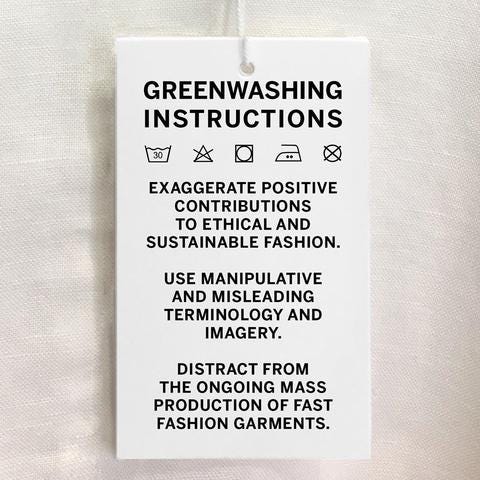Is your favourite brand ethical? The latest Green Fix newsletter.
What does greenwashing actually mean? An explanation and a roundup of news and climate action resources.
So. I left preparing this newsletter a little late this week.
Call it a personal failing. Work was busy, life was busy, and my ability to write coherently drops dramatically after about 8pm.
Anyway, it’s 10pm at the time of writing. I thought about delaying the Green Fix a day or two. Nobody is monitoring when I send it out. It’s just in the early days, I can get away with it. But my perfectionist need for consistency kicked in, the fear of not following through on my (self-imposed) deadlines.
But maybe I should have let it slide a couple of days. Because I want to move away from a mindset of perfection. In my own life, and also in sustainability.

There are plenty of people making admirable efforts to live zero-waste lives, grow their own vegetables, and who are willing to put time and money into finding ethical alternatives to every product. You know them - we are them. They’re inspiring.
However, it’s important to not lose sight of the bigger picture. Ultimately, saving the planet won’t come down to whether we bought our cucumber plastic-wrapped. Every little helps, as Tesco’s favourite mantra goes, but some things help more than others.
And I would argue that spending time feeling bad about the small changes you were unable to make - that last-minute plastic-wrapped sandwich at the airport, the guilt-riddled car journey - are the least helpful of all. While we worry about our individual carbon footprint, large corporations like Shell continue to pour oil into the ocean.
We don’t need to be perfect. We need to recognise that business models, laws and social divisions are in place that make it nearly impossible to do the right thing all the time, or to know what the ‘right’ thing even is.
We can’t shy away from the role of politics and economics - ignorance isn’t always bliss, and in this case, ignorance has rather bad consequences for, you know, the future of the world. Ignorance also helps governments and corporations keep on doing Bad Things, because we aren’t educating ourselves on it enough to challenge them.
So yes, buy that bamboo toothbrush if you can afford it. But we cannot let our individual conscious consumption distract us from speaking out about the biggest challenges facing our planet.
The Green Fix aims to provide some resources to do this. This relies on people sending in their questions, suggestions, and resources they’ve found useful. Shape the newsletter by filling in this feedback survey.
What’s Going On?
Last week, 64 world leaders pledged to put wildlife and nature at the heart of post-COVID recovery plans ahead of the UN Summit on Biodiversity.
Context: What is the UN Summit on Biodiversity?China pledges to become a carbon-neutral country by 2060.
Relevant: Can China become carbon-neutral by 2060?Figures by BP suggest that the world has already passed ‘peak oil.’
Useful context: What is ‘peak oil’?Also on oil: Investigation finds that BP and Shell back anti-climate lobby groups despite pledges.
A study in Nature Communications suggests that the Amazon is near tipping point of switching from rainforest to savannah.
Context: Why are rainforests important?
Focus On… Greenwashing

So what the hell is greenwashing? The Cambridge Dictionary defines it as “behaviour or activities that make people believe that a company is doing more to protect the environment than it really is.”
So what does that look like in practise?
This week, rather than find a guest writer for this section to explain for me, I tried something different (last-minute work is the origin of innovation).
I went on Instagram and asked for examples of businesses claiming to be green or sustainable that are sketchy at best, outright lies at worst. Here’s what some of you had to say:
“Companies like L’Oreal offering recycling schemes for their products that don’t actually work.”
“Primark making clothes out of sustainable materials.”
“H&M releasing a conscious collection, as if that makes up for everything else”
“ASOS introduced a new ‘circular line’.”
You get the picture. As words like 'green’ and ‘eco’ become appealing buzzwords to shoppers, businesses take note and put effort into making it look like they’re sustainable.
So how do you know when a seemingly ‘eco’ product may not be the real deal?
Green on the pictures =/= green business. A picture of a tree goes a long way towards misleading customers.

Empty buzzwords. There’s no standardised legal definition of words like eco-friendly, green, natural, so a company can easily slap it on the packaging. Look for concrete facts that back up these claims.
Linked to that, pay attention to terms like ‘recyclable.’ It might mean recyclable, if you’re prepared to drive 150 miles to the nearest industrial recycling facility.Self-awarded certifications. Look up the certifications they use - were they awarded by a third-party (like Fairtrade, Rainforest Alliance or B-Corp certification) - or did the company just award itself a sustainability sticker?
Fake or misleading ‘victories.’ This looks like companies advertising that their product doesn’t contain a chemical which is never usually there anyway, or the notorious example of Starbucks phasing out plastic straws - to be replaced with plastic lids.
Making small changes and ignoring the elephant in the room. Look, it’s great if the airline Ryanair have lowered their carbon emissions. They’re still a company in one of the most polluting sectors and run by someone who once suggested shooting environmentalists.

OK. So it can be paralysing to have to consider so many factors before buying, especially when half the necessary information isn’t available to us. So what can you do to avoid and prevent greenwashing?
Look on their website. Companies that are the real deal will have detailed pages with transparent information about what’s in their products, how it was produced and how they fulfil their ethical claims. Just saying ‘sustainable’ isn’t enough.
Check the certifications and see who awards them and what they mean.
Ask directly. If you’re sceptical or unsure of a claim, take 2 minutes to send the company an email or ask them on social media to provide more information about their ethics.
Focus on the facts. Don’t let pictures of wildlife and nature throw you off.
Shop at local and small businesses. Smaller businesses tend to have shorter and more transparent supply chains, and are likely to be more open about where their products come from.
Call out companies. If you see a potential or obvious sign of greenwashing, point it out! Tell your friends, family, social media, your postman - let’s stop each other falling into the same traps.
These are just a few tactics to look out for when weighing up a company claims. (For more detailed guides, I recommend this article by Zero Waste Chef, and this blog post).
So Now What Do I Do?
LEARN MORE
Read: “Here’s what it takes for fashion brands to be sustainable.”
What’s the difference between biodegradable and compostable?
TRY SOMETHING NEW
For those of you in the UK, try the Giki app which ranks supermarkets products by a range of sustainability criteria. (Outside the UK, you can check your favourite fashion brands on the Fashion Revolution Transparency Index).
Learn what actually happens at climate negotiations by tuning in to the Boiling Point series of webinars.
Support your local and purpose-driven businesses - on social media, reviewing them on Google, and of course - shopping there!
CHANGE THE SYSTEM
Vote with your wallet: consider boycotting unethical companies like Amazon. Look here if you’re not sure how to start.
Write a letter to a brand asking them to be transparent about the sustainability and ethics of their business practices. Fashion Revolution has guides for fashion brands, but they can be adapted for any organisation.
The EU has launched a public consultation for an initiative requiring companies to back up their green claims with evidence. Have your say!
Stay in the loop
The topic for the next Green Fix is decided through a weekly poll on my Instagram @coffee_and_casstaways, as well as feedback I receive. I also use Instagram to share additional resources and tips that don’t make it onto this newsletter. Say hi!




